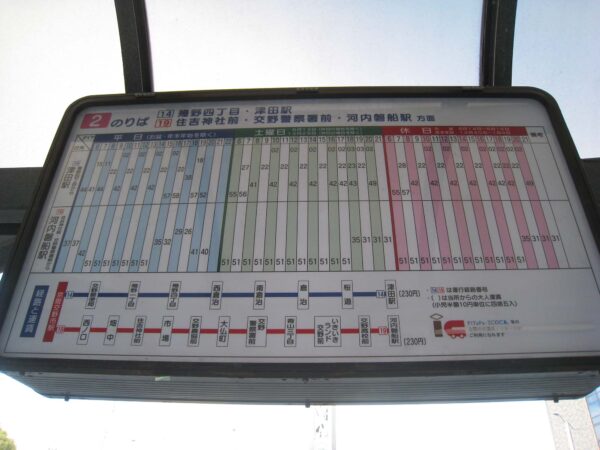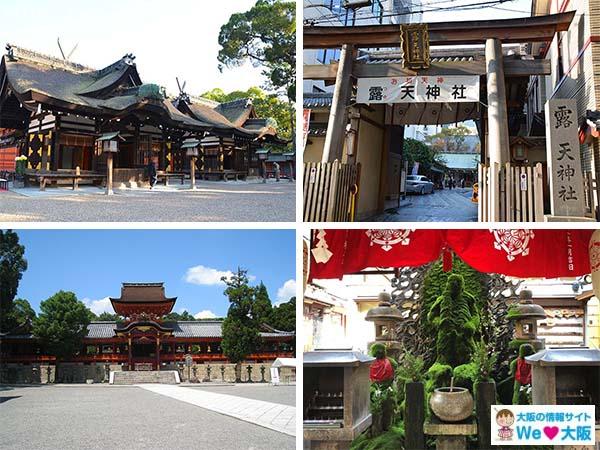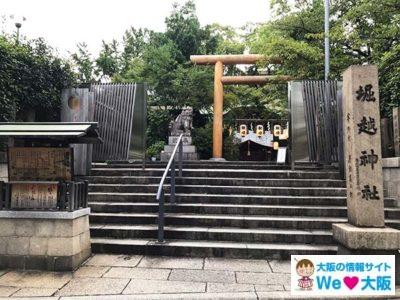- Top
- Shrines & Temples
- Hatamono Shrine- Birthplace of the Tanabata Legend and the Goddess Orihime
Hatamono Shrine- Birthplace of the Tanabata Legend and the Goddess Orihime
2023.02.09
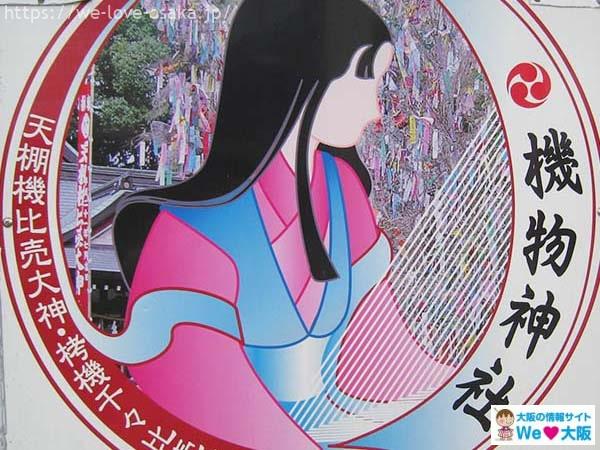
Hatamono Shrine enshrines Orihime, the goddess of the Tanabata legend. Many people have heard of Tanabata because of the holiday, but do not know much about it.
The city of Katano, where the shrine is located, was called Katanokehara during the Heian period (794-1192), more than 1,200 years ago, and was a resort for aristocrats. Katanokehara is the area between present-day Katano City and Hirakata City, and has been the site of the legend of Tanabata (the Star Festival) since the Heian period (794-1192), and is the subject of many waka poems.
Since those days, Hatamono Shrine has been dedicated to Orihime. Many people would like to visit the shrine at least once, but are not sure how to get there. So we will not only introduce you to the Hatamono Shrine, but also to the shrine’s red seals, some rare trees, and of course access information.
目次
1. What is Hatamono Shrine’s origin?
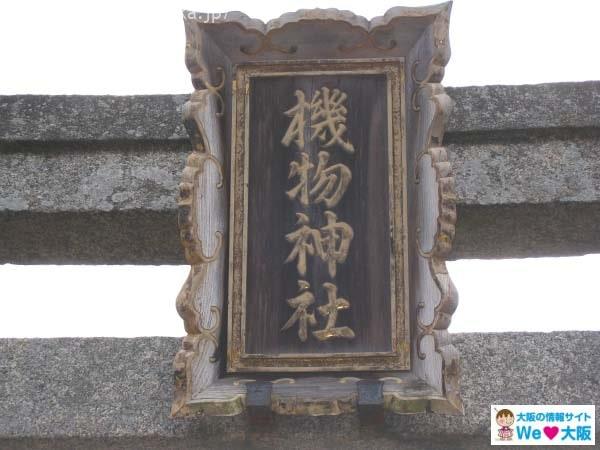 Hatamono Shrine is named for the 5th to 6th century Chinese traders who brought silk weaving technology and settled near the base of the mountains where this shrine is located. Hence the name Hatamono, which means “weaving.” Later, it is said that the shrine became associated with the Tanabata legend.
Hatamono Shrine is named for the 5th to 6th century Chinese traders who brought silk weaving technology and settled near the base of the mountains where this shrine is located. Hence the name Hatamono, which means “weaving.” Later, it is said that the shrine became associated with the Tanabata legend.
2. Who is the deity of Hatamono Shrine?
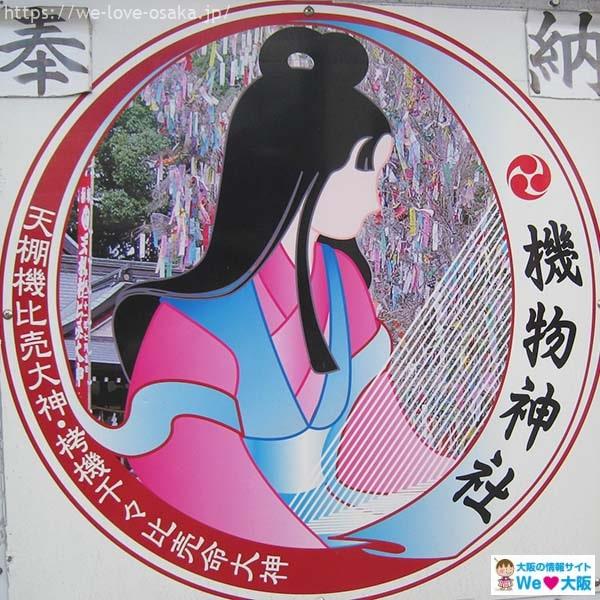 ・Amano Tanabata Hime God
・Amano Tanabata Hime God
・Takuhatachi Hime God
・Tokoshiro Nushi God
・Yae Kotoshiro Nushi God
Four deities are enshrined, and Amano Tanabata Hime is Orihime. The Goddess Orihime is said to have sewed various costumes for Amaterasu Omikami when he hid in Ama-no-Iwato (the cave of the sun), in order to lure him out of the cave. Because of this, she is also known as the goddess of weaving.
3. Orihime’s Loom
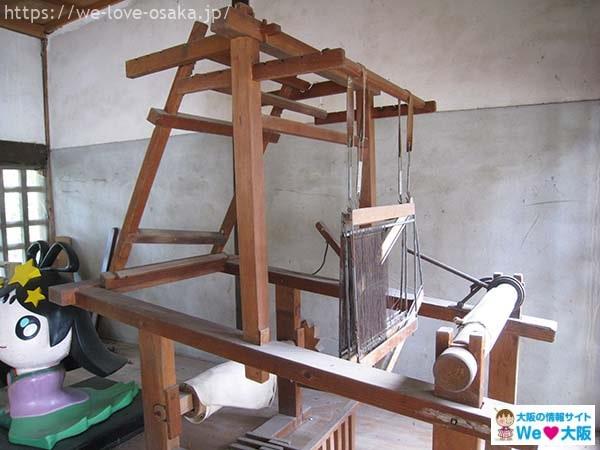 Here is Orihime’s loom. Did she also weave Amaterasu’s garments with it?
Here is Orihime’s loom. Did she also weave Amaterasu’s garments with it?
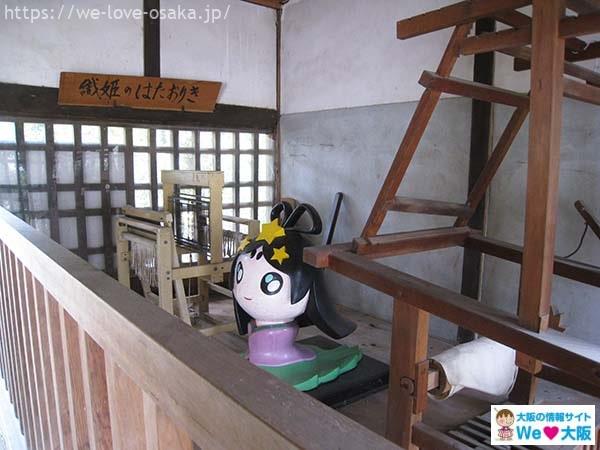 In the center is the mascot character “Orihime-chan” from Katano City.
In the center is the mascot character “Orihime-chan” from Katano City.
4. Postcard tree
One is planted on each side of the main shrine. I did not recognize it at first because its shape is not so different from the leaves of other trees.
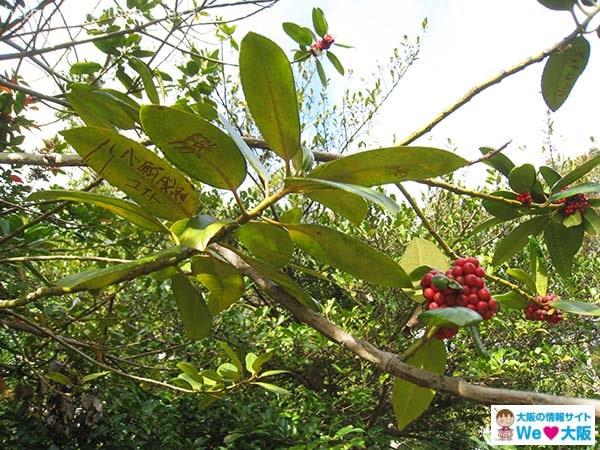 The postcard tree, as you can see, allows writing on its leaves. If you write on the underside of a leaf with a pointed branch that has fallen at your feet, the writing will come out. It is as clear as if you had written it with a ballpoint pen or something.
The postcard tree, as you can see, allows writing on its leaves. If you write on the underside of a leaf with a pointed branch that has fallen at your feet, the writing will come out. It is as clear as if you had written it with a ballpoint pen or something.
When I visited the shrine, many people were writing their wishes. This tree is said to be the origin of the word postcard.
5. Paper Mulberry
Next is the paper mulberry tree located next to the main shrine.
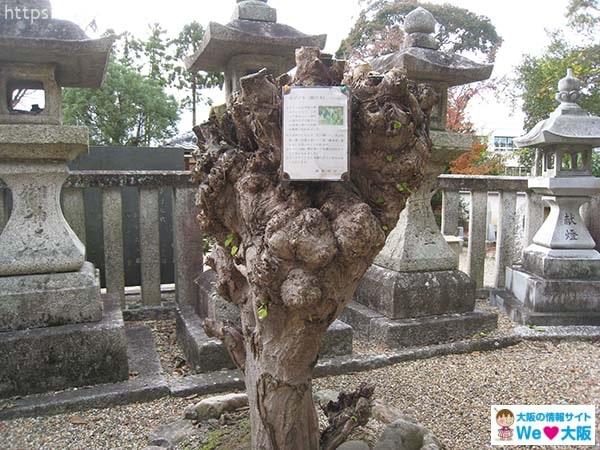 The paper mulberry tree planted in the precincts of shrines as an offering to the gods. It was also used as a tanzaku (paper strip) for the Tanabata Festival at court. You may not see this tree very often. Although it doesn’t look like much here, some small buds had sprouted, so I am sure they will grow many leaves in the future.
The paper mulberry tree planted in the precincts of shrines as an offering to the gods. It was also used as a tanzaku (paper strip) for the Tanabata Festival at court. You may not see this tree very often. Although it doesn’t look like much here, some small buds had sprouted, so I am sure they will grow many leaves in the future.
6. Shrine office monument
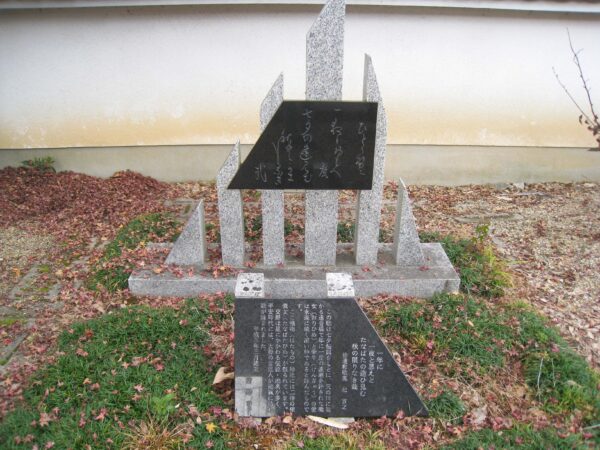 There is a poem written on this monument which goes like,
There is a poem written on this monument which goes like,
“Though it may seem like only one night a year, Tanabata no Awaichimu, Autumn has no end.”
This song refers to the love between the weaver Orihime and Kengyu, who are allowed to meet only once a year at the Aiai Bridge over the Milky Way on the night of Tanabata, is eternal.
*Kengyu is a young man who herds cows, and hisJapanese name is Hikoboshi (彦星).
Perhaps because the shrine enshrines a female deity, it is enveloped in a soft atmosphere.
7. A slightly unusual guardian dog
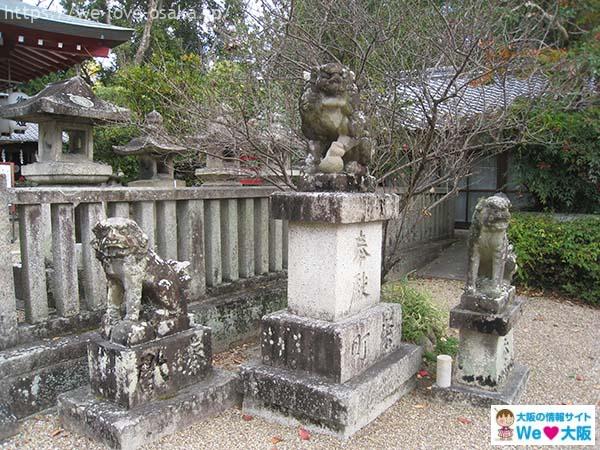 There are three guardian dogs to each side of the front of the main shrine of Hatamono Shrine. I thought it was a little unusual, since there is usually one on each side of the shrine. Perhaps they are there to protect the female deity.
There are three guardian dogs to each side of the front of the main shrine of Hatamono Shrine. I thought it was a little unusual, since there is usually one on each side of the shrine. Perhaps they are there to protect the female deity.
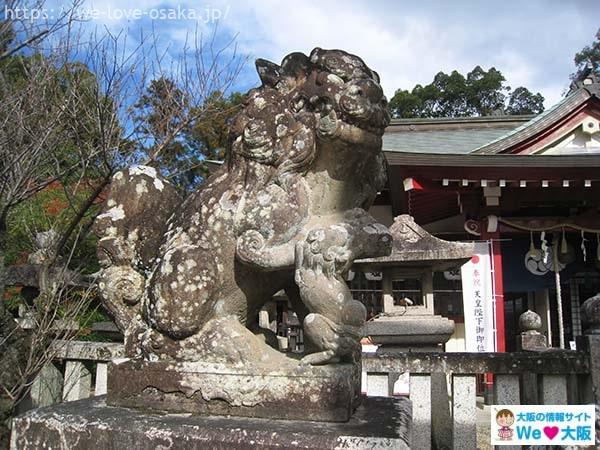 This is the guardian dog on the left. A small guardian dog, probably a baby, appears to be playing with a baby at his feet. These kinds of guardian dogs are not seen at other shrines.
This is the guardian dog on the left. A small guardian dog, probably a baby, appears to be playing with a baby at his feet. These kinds of guardian dogs are not seen at other shrines.
8. Hatamono Shrine’s Red Seal
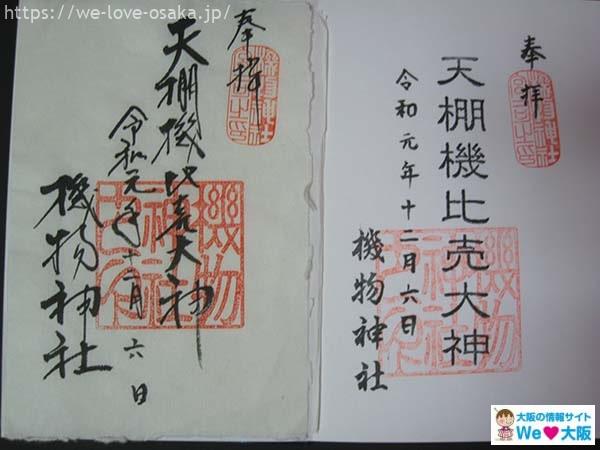 Here is the red seal of Hatamono Shrine. On the right is a seal stamped in a red seal book. The left one is a note, but written in black ink.
Here is the red seal of Hatamono Shrine. On the right is a seal stamped in a red seal book. The left one is a note, but written in black ink.
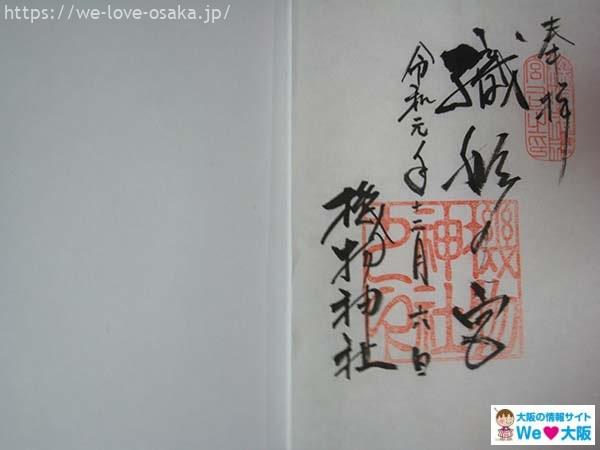 Here is another one. It is written in ink, “Orihime no Miya”. This time, I received three kinds of red seals. They cost 300 yen each.
Here is another one. It is written in ink, “Orihime no Miya”. This time, I received three kinds of red seals. They cost 300 yen each.
Where can I get a red seal?
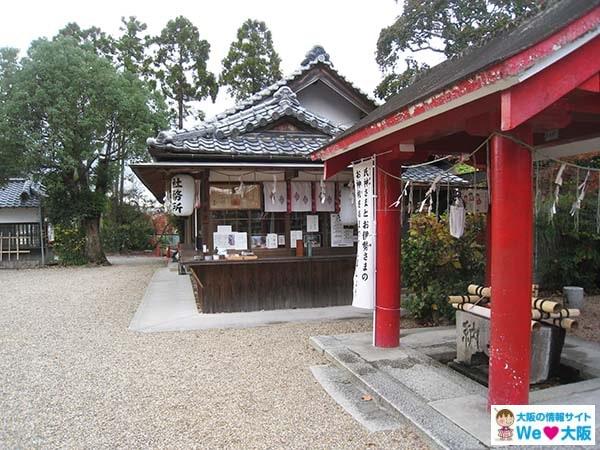 Red seals can be obtained at the shrine office located next to the hand-watering basin, just after passing through the torii gate. If no one is at the shrine office, press the bell on the left. The company office is open from 10:00 to 16:00.
Red seals can be obtained at the shrine office located next to the hand-watering basin, just after passing through the torii gate. If no one is at the shrine office, press the bell on the left. The company office is open from 10:00 to 16:00.
9. Are there any festivals?
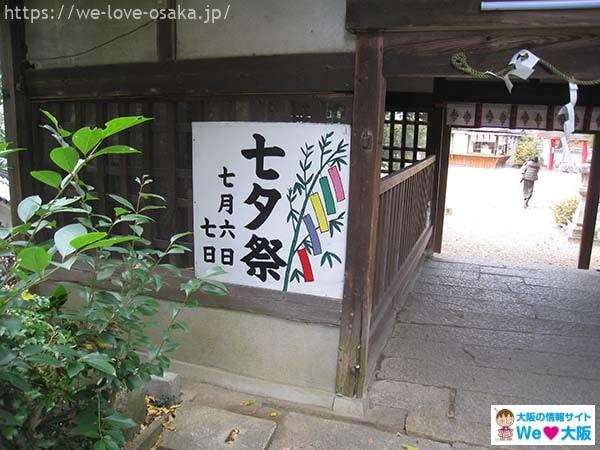 Every year, the Tanabata Festival is held on July 6 and 7. On the day of the festival, the shrine grounds are filled with bamboo branches and strips of paper. The written strips of paper are then washed into the Milky Way.
Every year, the Tanabata Festival is held on July 6 and 7. On the day of the festival, the shrine grounds are filled with bamboo branches and strips of paper. The written strips of paper are then washed into the Milky Way.
10. Access
There are two routes to Hatamono Shrine.
Bus from Katano City Station of Keihan Railway
Bus from Korien Station of Keihan Railway
First, we will introduce the route using the bus from Katano City Station.
Route from Katanoshi Station (Katanoshi, Keihan Railway)
To get to Katanoshi Station, transfer to the Katano Line at Hirakatai-shi Station. First, let us show you how to transfer to the Katano Line.
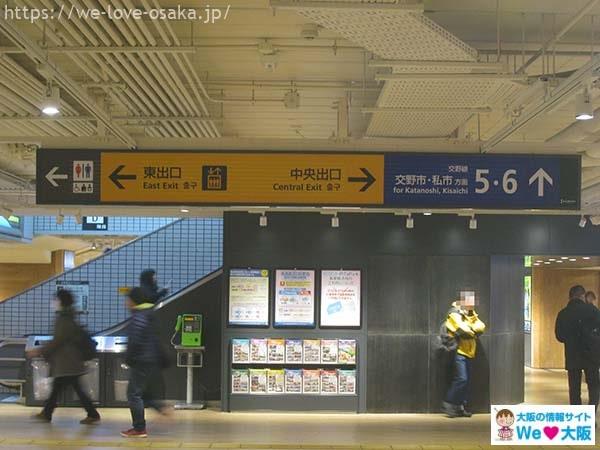 This is the concourse from platforms 1 and 2 (to Kyoto). For the Katano Line platforms 5 and 6, look to the right at the central exit and go straight ahead.
This is the concourse from platforms 1 and 2 (to Kyoto). For the Katano Line platforms 5 and 6, look to the right at the central exit and go straight ahead.
Those coming from platforms 3 or 4 (to Osaka) can also find platforms 5 or 6 by looking to the right at the Central Exit and going straight.
There are three platforms at Hirakata-shi Station: platforms 1 and 2, platforms 3 and 4, and platforms 5 and 6 of the Katano Line, so there is little worry about getting lost.
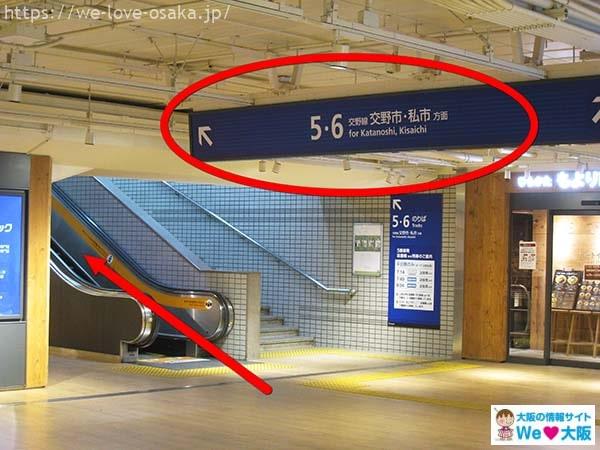 Take the escalator up.
Take the escalator up.
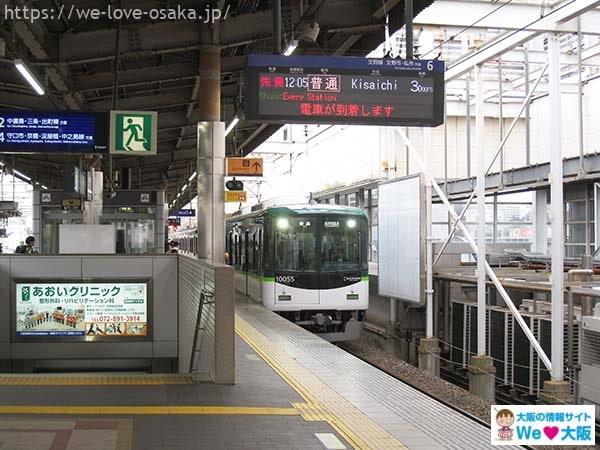 This is the platform of the Katano Line. All Katano line trains stop at each station and only go to Iichi, the last stop. There is no need to worry about getting on the wrong train. Also, the rear cars are more empty.
This is the platform of the Katano Line. All Katano line trains stop at each station and only go to Iichi, the last stop. There is no need to worry about getting on the wrong train. Also, the rear cars are more empty.
On the Katano Line, trains depart every 10 minutes. You are not likely to miss your train and waste time.
Access to Hatamono Shrine from Katanoshi Station on the Keihan Railway
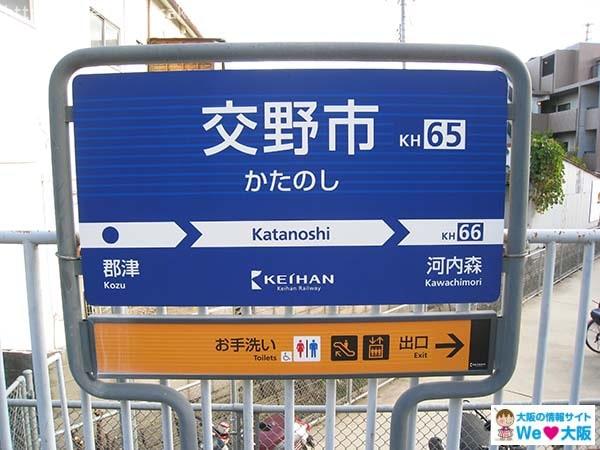
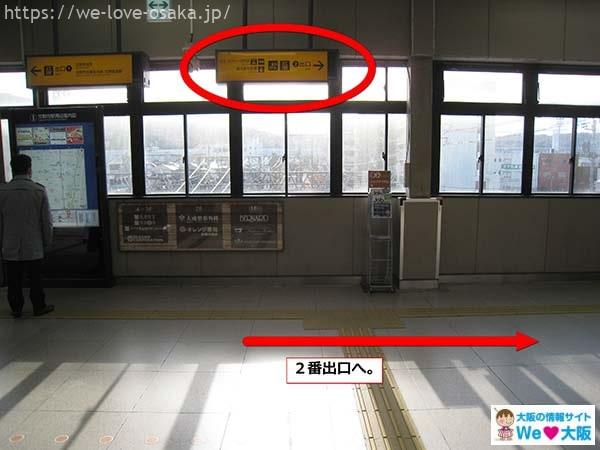 There is only one exit from Katanoshi Station. After exiting the ticket gate, turn right toward Exit 2. After a short walk, you will see a down escalator in front of you on your left. Take the escalator down to the first floor.
There is only one exit from Katanoshi Station. After exiting the ticket gate, turn right toward Exit 2. After a short walk, you will see a down escalator in front of you on your left. Take the escalator down to the first floor.
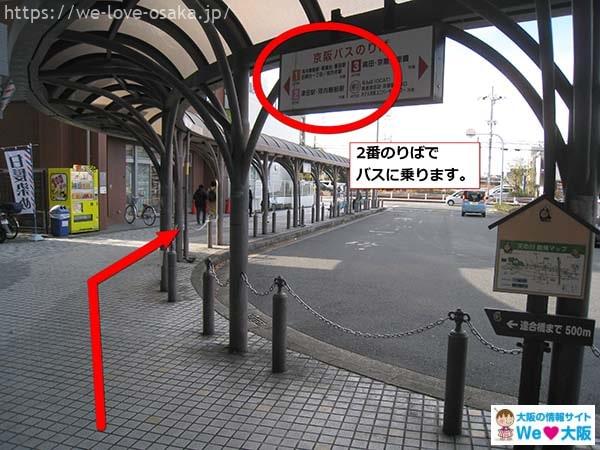 After exiting the exit, you will immediately see the bus terminal. To get to Kuraji, the closest bus stop to Hatamono Shrine, take the bus bound for “Tsuda Station” at the No. 2 bus stop.
After exiting the exit, you will immediately see the bus terminal. To get to Kuraji, the closest bus stop to Hatamono Shrine, take the bus bound for “Tsuda Station” at the No. 2 bus stop.
The bus to Tsuda Station departs every 40 minutes. If you have some time before the bus departs, you can use the eat-in corner in the station building. It is located right in front of the bus stop, so you will know immediately when the bus arrives.
It takes about 30 minutes to reach Hatamono Shrine on foot. The first time I visited the shrine, I had some time before the next bus, so I walked there. But it was uphill all the way, and I noticed after getting on the bus that there were places where I had to turn right and then left.
If you take the wrong route, you will not be able to reach Hatamono Shrine, nor will you be able to board a bus. If you are not familiar with the route, we recommend that you take the bus.
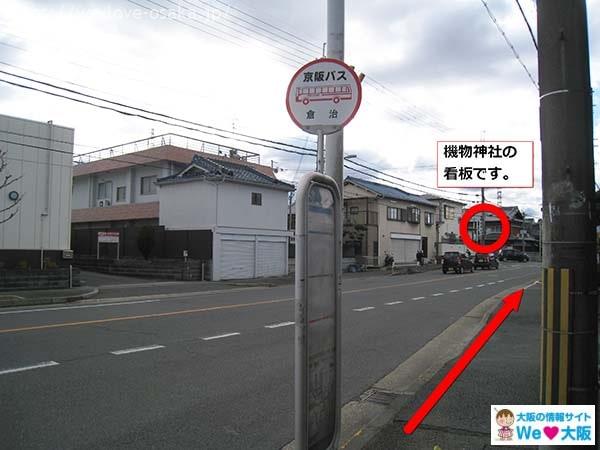 This is the Kuraji bus stop. You will see the sign for Hatamono Shrine on your left. Also, the bus stop for the return trip is across the street, on the front.
This is the Kuraji bus stop. You will see the sign for Hatamono Shrine on your left. Also, the bus stop for the return trip is across the street, on the front.
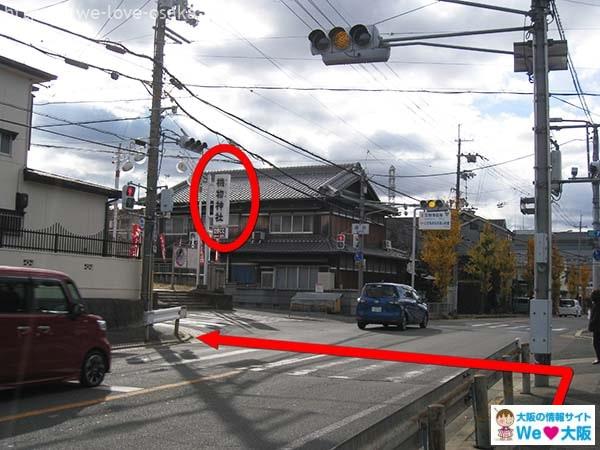 From the bus stop, turn left at the first traffic light. At the entrance to Hatamono Shrine, cross the pedestrian crossing again. Please be careful of traffic lights and cars.
From the bus stop, turn left at the first traffic light. At the entrance to Hatamono Shrine, cross the pedestrian crossing again. Please be careful of traffic lights and cars.
Return from Hatamono Shrine
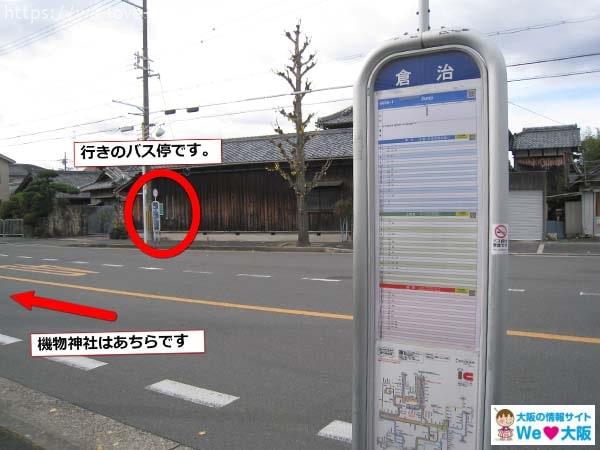 This is the return bus stop. You can see the bus stop you got off at on the way there in the left foreground.
This is the return bus stop. You can see the bus stop you got off at on the way there in the left foreground.
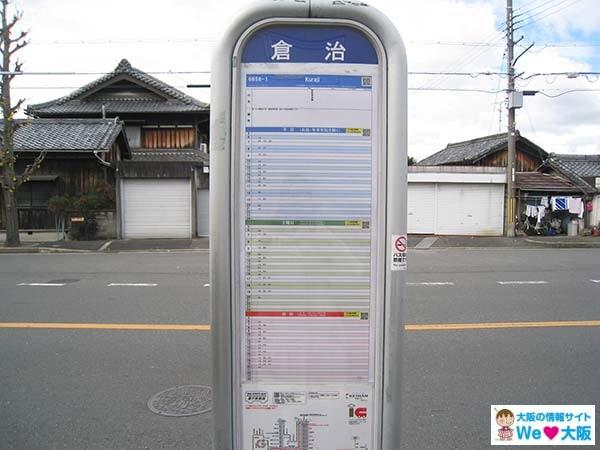 Buses departing from the Kuraji bus stop depart every 40 minutes, except in the evening on weekends and holidays. Please pay attention to the bus departure time.
Buses departing from the Kuraji bus stop depart every 40 minutes, except in the evening on weekends and holidays. Please pay attention to the bus departure time.
Buses arriving at this bus stop will take you to Korien Station on the Keihan Railway. Get off at Katanoshi Station and transfer to a Keihan train to go home. Ride to the last stop, Korizono Station, and take the Keihan train home. Choose the most convenient route for you (including transportation costs!) from the two routes. Please choose one of the two routes.
Access from Korien Station on Keihan Railway
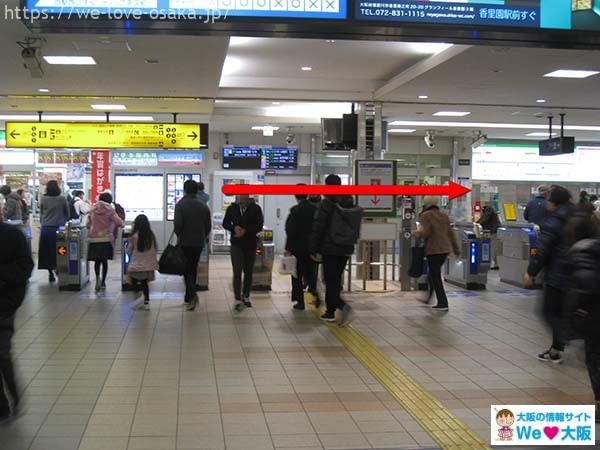 There is only one exit from Korien Station of Keihan Railway. After exiting the exit, turn right.
There is only one exit from Korien Station of Keihan Railway. After exiting the exit, turn right.
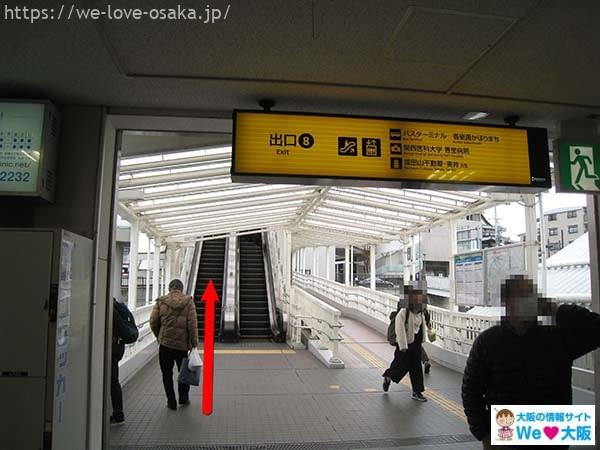 Use the up escalator.
Use the up escalator.
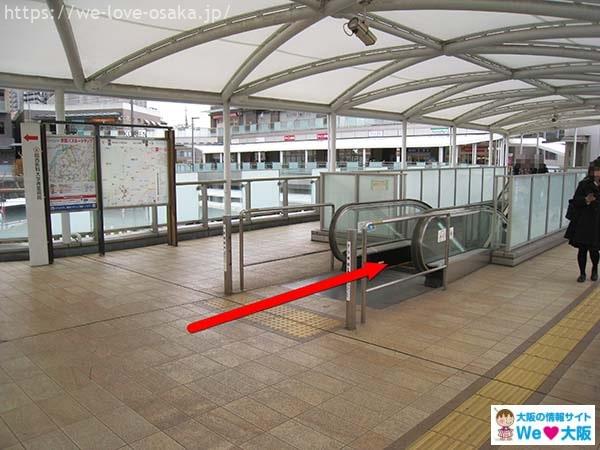 Go straight down the up escalator and you will see a down escalator on your right. Use this escalator.
Go straight down the up escalator and you will see a down escalator on your right. Use this escalator.
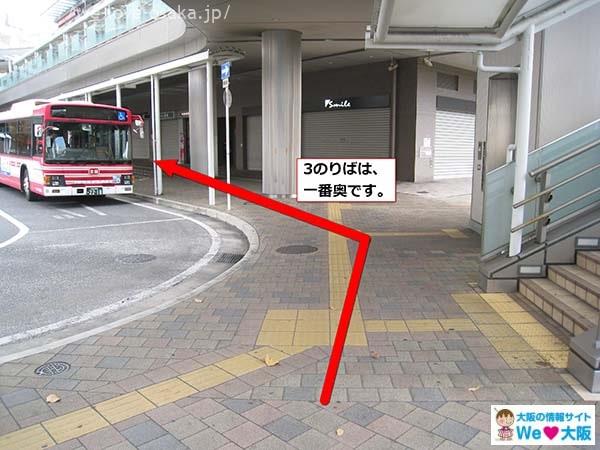 At the bottom of the escalator.
At the bottom of the escalator.
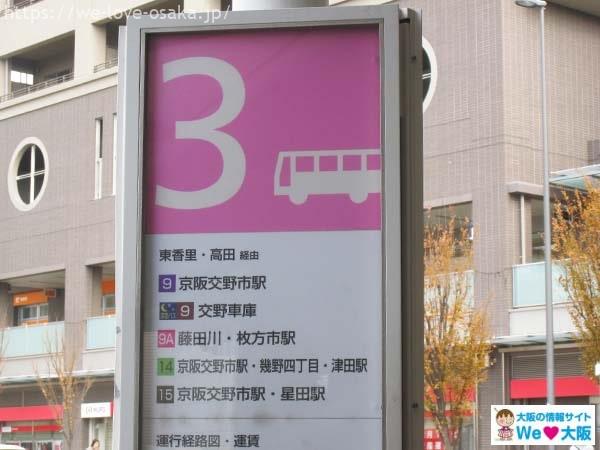 This is where you board the “14” Keihan train bound for Katanoshi, Ikuno 4-chome, Tsuda Station.
This is where you board the “14” Keihan train bound for Katanoshi, Ikuno 4-chome, Tsuda Station.
| 9 | 01 41 |
| 10 | 21 |
| 11 | 01 41 |
| 12 | 21 |
| 13 | 01 41 |
The timetable of the 3 bus stops is difficult to understand because it includes 6 different routes, so we have made a table showing only the departure times for trains bound for Tsuda Station. (The timetable is the same on weekdays and holidays.)
What about the return trip?
The return trip is the same as the return trip from Kimono Shrine introduced earlier.
All timetables presented here are current as of December 8, 2019.
11. Basic information
Address: 1-1-7 Kuraji, Katano, Osaka
TEL:072-891-4418 (company office)
Reception hours: 10:00 to 16:00 (may be unavailable due to business needs, etc.)
Access:
Approximately 15 minutes by bus and on foot from Katano City Station of Keihan Railway
Approximately 40 minutes by bus and walk from Korien Station on the Keihan Railway
12. Summary
What did you think of the Hatamono Shrine, home to the goddess Orihime of the Tanabata legend? On your next day off, why not spend a wonderful time surrounded by the gentle atmosphere of Hatamono Shrine?
▼Click here for many more power spots in Osaka
Related article
-

Osaka City Central Public Hall – A detailed guide to this retro landmark
Here is a special guided tour ……2023.03.20
-
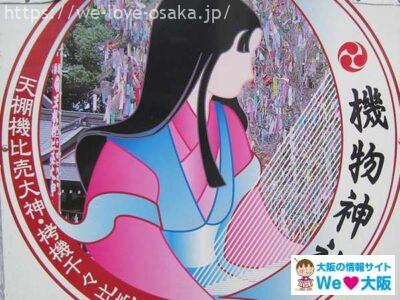
Hatamono Shrine- Birthplace of the Tanabata Legend and the Goddess Orihime
Hatamono Shrine enshrines Orih……2023.02.09
-
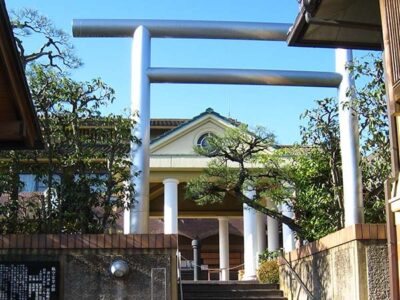
Hiko Shrine – Pray for a safe flight and fold your fortune into a paper airplane at “The Shrine of Flight”
Hiko Shrine translates as "The……2023.02.09







